NEET Chemistry is the scoring paper in the medical entrance examination. Here, you will discover the NEET Chemistry MCQ Questions for all Concepts as per the latest syllabus. Practice more on a regular basis with these NEET Chemistry objective questions on air pollution and improve your subject knowledge & problem-solving skills along with time management. NEET Chemistry Hybridisation Multiple Choice Questions make you feel confident in answering the question in the exam & increases your scores to high.
MCQs on Hybridisation
1. The compound which contains both ionic and covalent bond:
(a) KCl
(b) KCN
(c) CH4
(d) H2
Answer
Answer: (b)
2. The maximum number of 90o angles between bond pair-bond pair of electrons is observed in
(a) dsp2 hybridisation
(b) sp3d hybridisation
(c) dsp3 hybridisation
(d) sp3d2 hybridisation
Answer
Answer: (d)
3. Ether is more volatile than alcohol having the same molecular formula. This is due to
(a) alcohols having resonance structures
(b) intermolecular hydrogen bonding in ethers
(c) intermolecular hydrogen bonding in alcohols
(d) the dipolar character of ethers
Answer
Answer: (c)
4. The main axis of a diatomic molecule is z, molecular orbital px and py overlap to form which of the following orbital?
(a) pi molecular orbital
(b) sigma molecular orbital
(c) gamma molecular orbital
(d) No bond will be formed
Answer
Answer: (a)
5. Total number of lone pair of electrons in I3- ion is
(a) 3
(b) 6
(c) 9
(d) 12
Answer
Answer: (c)
6. BCl3 is a planar molecule whereas NCl3 is pyramidal because
(a) B-Cl bond is more polar than NaCl bond
(b) N-Cl bond is more covalent than B-Cl bond
(c) the nitrogen atom is smaller than boron atom
(d) BCl3 has no pair but NCl3 has a lone pair of electrons
Answer
Answer: (d)
7. In which solvent NaCl has maximum solubility?
(a) H2O
(b) C2H5OH
(c) CH3COCH3
(d) C2H5OC2H5
Answer
Answer: (a)
8. Which one of the following pairs of molecules will have permanent dipole moments for both members?
(a) NO2 and CO2
(b) NO2 and O3
(c) SiF4 and CO2
(d) SiF4 and NO2
Answer
Answer: (b)
9. Which of the following compounds has the smallest bond angle in its molecule?
(a) H2O
(b) H2S
(c) NH3
(d) SO2
Answer
Answer: (b)
10. Which one of the following properties is not shown by NO?
(a) it is diamagnetic in the gaseous state
(b) it is a neutral oxide
(c) it combines with oxygen to form nitrogen dioxide
(d) its bond order is 2.5
Answer
Answer: (a)
